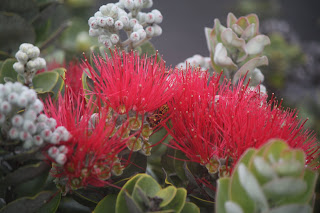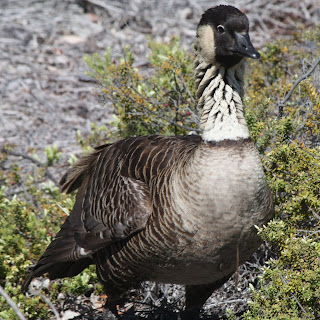Part 5
(View Part I—Overview)
Just a mile outside of Hawai’i Volcanoes National Park, the Hale Ohia Cottages provided us with a cozy room in a rustic wooden building. The room featured a queen bed, a mini-fridge, a couple of chairs, and a generously sized bathroom. While technically a bed and breakfast, breakfast was in-room coffee, freshly baked bread, fruit, and juice. I had to ask for hot water for tea, and the rusted out electric teapot sent me looking for take-out tea the next morning. Because breakfast is delivered the day before to your room, you miss out on the usual camaraderie among guests that bed and breakfasts typically provide.
Volcano at night can be quite chilly, with temperatures dipping below 50. So, while the space heater in the room generates warmth, we really wanted to hang out in a common room with a roaring fire. The fireplace in the common room was dormant and no one was around.

The next morning we drove to the park (paid our $10 entrance fee, which is good for seven days) to explore a not-so-dormant volcano, the mighty Kilauea.
Note: Areas in the park are always subject to closure due to current activity of Kilauea. A portion of Crater Rim Drive, between Jaggar Museum and the Chain of Craters Road junction is closed indefinitely due to the new vent that opened within Halema`uma`u Crater in March 2008. Halema`uma`u Crater is within the Kilauea Crater. (Link to closures in Hawai’i Volcanoes National Park here.)We elected to hike the Kilauea Iki Trail. The Kilauea Iki (“little Kilauea”) is a crater within a crater. It erupted in 1959, providing fountains of gushing lava up to 1900 feet above the vent. The hike is approximately 4 miles long and takes you through lush rain forest before descending about 400 feet onto the crater floor. You walk across the crater floor, viewing steam vents and vegetation that struggles to retake its place amidst the cooled lava. ‘Ohi’a blossoms, ‘ohelo berries, and ferns dot the floor. In some cases, ferns sprout from cracks in the lava floor.


Back up to the top, you can take a short detour and view the Thurston Lava tube. Lava tubes form when surface lava cools while hot lava underground continues to flow. When the flow stops, a hollowed-out tube remains. The current lava flow from the Pu’u O’o vent travels to the ocean in similar tubes.

We finished our hike ready for lunch and our next adventure: finding a place to watch the Pittsburgh – Jets playoff game. (Love is a compromise! I get my morning hike and he gets his afternoon football. The good thing is that he enjoys hiking and I enjoy watching football!) We drove back down highway 11 to Hilo and found Cronies Sports Bar & Grill (11 Waianuenue Avenue, Hilo), a great sports bar with many large-screen TVs. Volcano Village is a bit lacking with places open on Sunday afternoon to catch an NFL playoff game. Bonus: we met some very nice and knowledgeable Hilo football fans!


The next morning, we selected our second hike. A fairly short hike (2.5 mile round trip) takes you to the top of the Pu’u Huluhulu cinder cone, providing a nice view looking towards Pu’u ‘O’o. You walk through old lava flows filled with lava trees, structures that echo trees destroyed by lava. Before succumbing, these moisture-filled trees cool the surrounding lava quickly enough to preserve their shapes.
 Next: Snorkeling with the Dolphins
Next: Snorkeling with the Dolphins


No comments:
Post a Comment